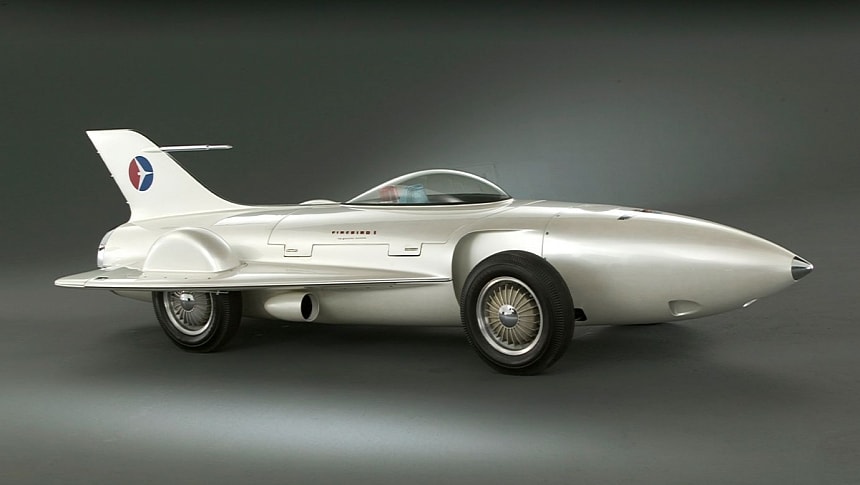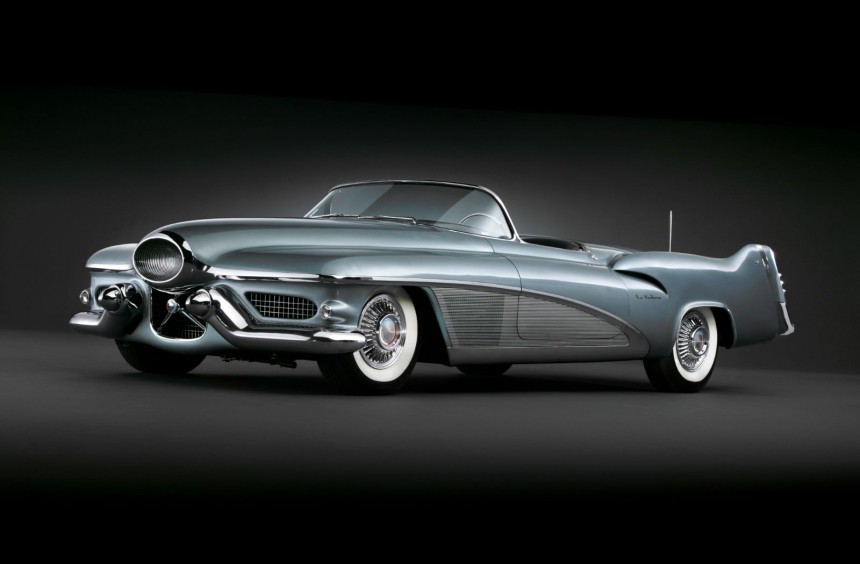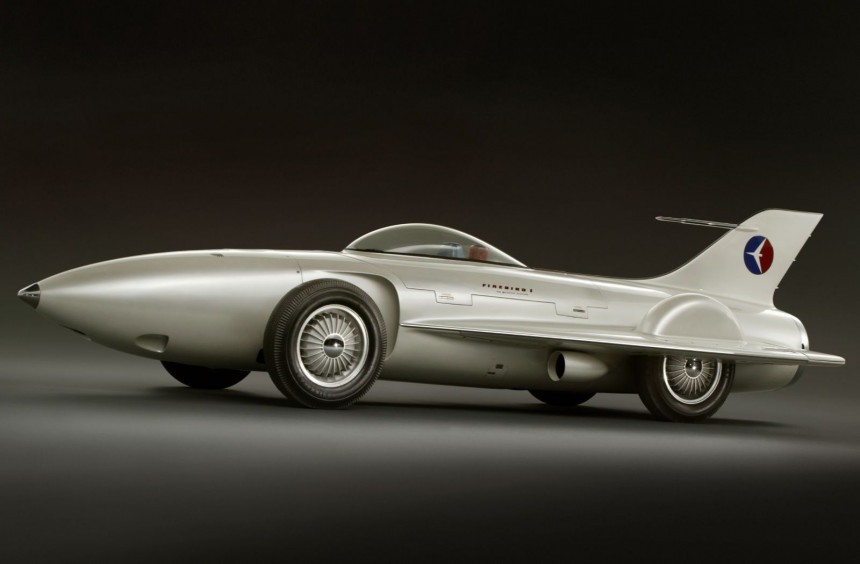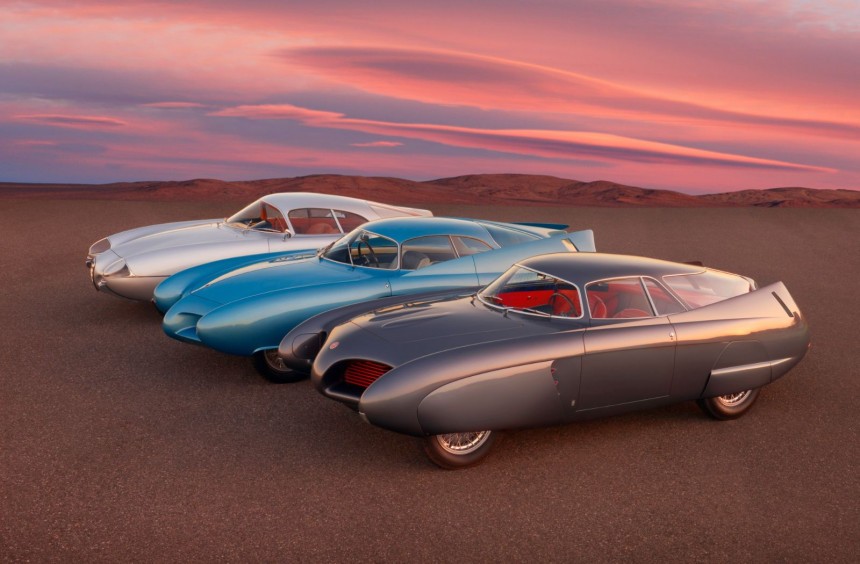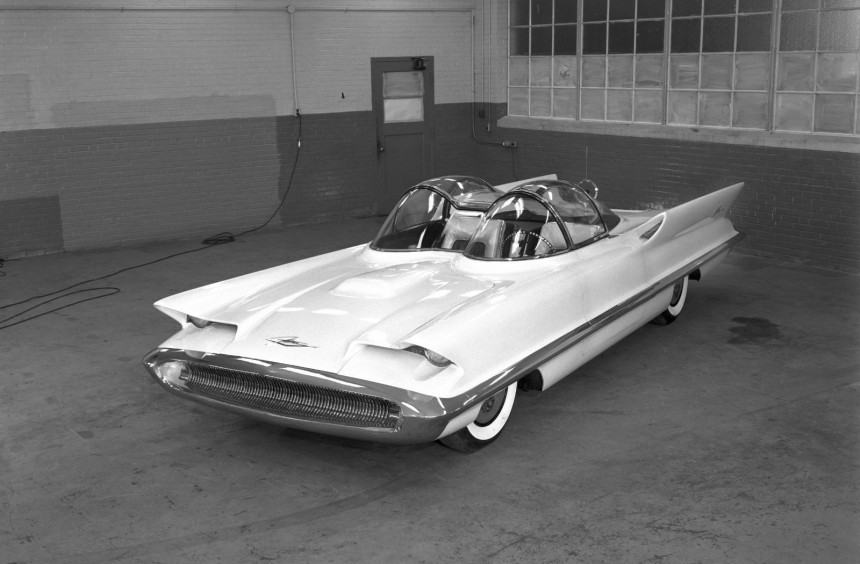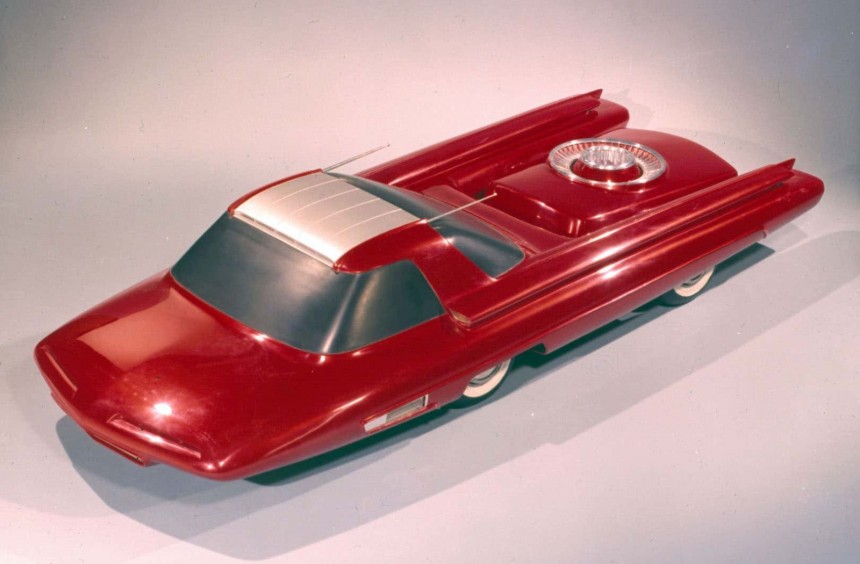Though the idea of what we now call concept cars was still relatively new, the 1950s saw the birth of some legendary one-offs that are still fascinating today.
Initially called dream cars or idea cars and often built in a single unit, these vehicles have been developed to showcase carmakers' design capabilities as well as innovative technologies.
It all started in 1938 with the Harley J. Earl-designed Buick Y-Job, then, in the years that followed, other carmakers began following suit.
By the 1950s, concept cars became mainstream among American carmakers, and even European manufacturers began showcasing their futuristic vehicles.
Heavily influenced by the Jet Age and exulting the confidence of the post-war boom, 1950s concept cars were flashy and futuristic.
Although the automotive industry, and, consequently, future concept cars, have evolved tremendously over the last seventy years, some 1950s dream cars, like the five we're about to remember, are still fascinating today.
Apart from the first-ever concept car, General Motors was responsible for some of the greatest concepts of the 1950s, and arguably the most legendary was the 1951 LeSabre.
Designed by the famous Harley J. Earl, the LeSabre featured a gorgeous jet-inspired two-door convertible body comprised of a mix of aluminum, magnesium, and fiberglass panels.
It was powered by an all-aluminum supercharged V8 that could run on gasoline or methanol. Rated at 335 hp, the engine was linked to an automatic transmission mounted at the rear for better weight distribution.
Unlike the production cars of the era, which used a 6-volt electrical system, the LeSabre employed an innovative 12-volt system. Moreover, it featured built-in electric lifting jacks, electric concealed headlights, and a power top that could raise automatically thanks to a built-in water sensor.
Credited for inspiring numerous production cars of the 1950s, the LeSabre was kept by GM, and it currently resides at the corporation's Heritage Center in Sterling Heights, Michigan.
Long before it was used by Pontiac's legendary pony car, the Firebird nameplate debuted on the most Jet Age concept car of all time: GM's XP-21.
Basically a fighter jet with wheels, the XP-21 Firebird (aka Firebird I) was designed by, you guessed it, Harley J. Earl.
Its body (or rather fuselage) was fabricated from fiberglass-reinforced plastic and was heavily inspired by the delta-winged Douglas F4D Skyray fighter jet.
The Firebird didn't just look like a fighter jet but was also powered by a two-part turbine engine. Dubbed Whirlfire Turbo-Power, the experimental powerplant developed under the supervision of Charles L. McCuen was allegedly capable of delivering 370 hp.
Theoretically, the concept could reach a top speed of 200 mph (322 kph) but, nobody was brave enough to go over the 100 mph (160 kph) mark during real-world tests.
The XP-21 Firebird made its debut at the 1954 Motorama, where it made jaws drop to the floor. It was followed by three additional jet-inspired Firebirds concepts, and like other iconic GM concepts, it can now be admired at the corporation's Heritage Center.
The vast majority of futuristic concept cars born during the 1950s came from the US. However, some European carmakers also began thinking well outside the box during that decade, and arguably, the most famous example is Alfa Romeo and its BAT (Berlina Aerodinamica Tecnica) series.
During the early 1050s, Alfa commissioned Nuccio Bertone and his famous design house to create three concept cars that focused on aerodynamics.
Working with Alfa Romeo 1900 chassis and aiming to create a vehicle with the lowest possible drag coefficient, Bertone's Franco Scaglione finished the first BAT (confusingly named BAT 5) concept in 1953.
Its gorgeous streamlined body, which featured wheel covers and curved windows to maximize airflow, was theoretically capable of achieving 120 mph (200 kph) with a stock, 100-hp Alfa four-cylinder.
The idea was improved on the 1954 BAT 7, which received a series of upgrades that reduced the drag coefficient from 0.23 (of the BAT 5) to 0.19.
The final concept of the series was introduced in 1955. Dubbed BAT 9, it was more of a show car than a further aerodynamic evolution of its predecessors. Though it still looked futuristic, it featured several exterior trims, making it look more like Alfa Romeo's production models.
All three cars have survived and switched owners several times in the following decades. Most recently, the trio was auctioned off by RM Sotheby's, fetching no less than $14.840 million.
Apart from GM, Ford also played an important role in the popularization of the concept car during the 1950s.
Unquestionably, the most iconic FoMoCo concept of that exciting decade was the Lincoln Futura.
The brainchild of Ford stylist Bill Schmidt, who drew inspiration for the design from a close encounter with a shark, the Futura was conceived alongside another legendary Ford stylist, John Najjar.
Donning a lavish body with a double-bubble clear glass canopy top and large tailfins, the Futura was powered by a 368-ci(6.0-liter) OHV Y-block V8 coupled to a three-speed Turbo Drive automatic gearbox.
The concept was unveiled at the 1955 Chicago Auto Show, and four years later, it made its big-screen debut in the Holywood romantic comedy "It Started with a Kiss."
Ford subsequently sold the Futura to custom car legend George Barris, who transformed it into the Batmobile for the 1960s Batman television series.
In its original form, the Futura was one of the most breathtaking concept cars of the 1950s, and as the Batmobile, it became one of the most famous movie cars ever created.
Though it didn't survive in its original form, the Futura became one of the most famous TV cars.
While the Lincoln Futura was Ford's most famous 1950s concept car, the Nucleon was undoubtedly the corporation's wildest.
Developed in 1958, the concept looked like a blend between a pickup truck and a speed boat, yet its appearance wasn't the wildest thing about it.
As the name implies, Ford wanted to power the vehicle with a small nuclear reactor. Yes, you read that right, a scaled-down nuclear reactor inspired by those who went on to power military submarines.
Nuclear energy was relatively new, so it was deemed safe and environmentally friendly back then. Ford reasoned that it was bound to revolutionize the automotive sector and intended to get a head start on the competition.
But while the idea seemed good in theory, it was impossible to put into practice, so the Nucleon project ceased at the scale model stage.
Even if a functional, full-size model was never built, the Ford Nucleon remains one of the wildest, most futuristic concept cars of the 1950s.
It all started in 1938 with the Harley J. Earl-designed Buick Y-Job, then, in the years that followed, other carmakers began following suit.
By the 1950s, concept cars became mainstream among American carmakers, and even European manufacturers began showcasing their futuristic vehicles.
Heavily influenced by the Jet Age and exulting the confidence of the post-war boom, 1950s concept cars were flashy and futuristic.
Although the automotive industry, and, consequently, future concept cars, have evolved tremendously over the last seventy years, some 1950s dream cars, like the five we're about to remember, are still fascinating today.
1951 General Motors LeSabre
Designed by the famous Harley J. Earl, the LeSabre featured a gorgeous jet-inspired two-door convertible body comprised of a mix of aluminum, magnesium, and fiberglass panels.
It was powered by an all-aluminum supercharged V8 that could run on gasoline or methanol. Rated at 335 hp, the engine was linked to an automatic transmission mounted at the rear for better weight distribution.
Unlike the production cars of the era, which used a 6-volt electrical system, the LeSabre employed an innovative 12-volt system. Moreover, it featured built-in electric lifting jacks, electric concealed headlights, and a power top that could raise automatically thanks to a built-in water sensor.
Credited for inspiring numerous production cars of the 1950s, the LeSabre was kept by GM, and it currently resides at the corporation's Heritage Center in Sterling Heights, Michigan.
1953 GM XP-21 Firebird
Basically a fighter jet with wheels, the XP-21 Firebird (aka Firebird I) was designed by, you guessed it, Harley J. Earl.
Its body (or rather fuselage) was fabricated from fiberglass-reinforced plastic and was heavily inspired by the delta-winged Douglas F4D Skyray fighter jet.
The Firebird didn't just look like a fighter jet but was also powered by a two-part turbine engine. Dubbed Whirlfire Turbo-Power, the experimental powerplant developed under the supervision of Charles L. McCuen was allegedly capable of delivering 370 hp.
Theoretically, the concept could reach a top speed of 200 mph (322 kph) but, nobody was brave enough to go over the 100 mph (160 kph) mark during real-world tests.
The XP-21 Firebird made its debut at the 1954 Motorama, where it made jaws drop to the floor. It was followed by three additional jet-inspired Firebirds concepts, and like other iconic GM concepts, it can now be admired at the corporation's Heritage Center.
1953-1955 Alfa Romeo BAT Series
During the early 1050s, Alfa commissioned Nuccio Bertone and his famous design house to create three concept cars that focused on aerodynamics.
Working with Alfa Romeo 1900 chassis and aiming to create a vehicle with the lowest possible drag coefficient, Bertone's Franco Scaglione finished the first BAT (confusingly named BAT 5) concept in 1953.
Its gorgeous streamlined body, which featured wheel covers and curved windows to maximize airflow, was theoretically capable of achieving 120 mph (200 kph) with a stock, 100-hp Alfa four-cylinder.
The idea was improved on the 1954 BAT 7, which received a series of upgrades that reduced the drag coefficient from 0.23 (of the BAT 5) to 0.19.
The final concept of the series was introduced in 1955. Dubbed BAT 9, it was more of a show car than a further aerodynamic evolution of its predecessors. Though it still looked futuristic, it featured several exterior trims, making it look more like Alfa Romeo's production models.
All three cars have survived and switched owners several times in the following decades. Most recently, the trio was auctioned off by RM Sotheby's, fetching no less than $14.840 million.
1954 Lincoln Futura
Unquestionably, the most iconic FoMoCo concept of that exciting decade was the Lincoln Futura.
The brainchild of Ford stylist Bill Schmidt, who drew inspiration for the design from a close encounter with a shark, the Futura was conceived alongside another legendary Ford stylist, John Najjar.
Donning a lavish body with a double-bubble clear glass canopy top and large tailfins, the Futura was powered by a 368-ci(6.0-liter) OHV Y-block V8 coupled to a three-speed Turbo Drive automatic gearbox.
The concept was unveiled at the 1955 Chicago Auto Show, and four years later, it made its big-screen debut in the Holywood romantic comedy "It Started with a Kiss."
Ford subsequently sold the Futura to custom car legend George Barris, who transformed it into the Batmobile for the 1960s Batman television series.
In its original form, the Futura was one of the most breathtaking concept cars of the 1950s, and as the Batmobile, it became one of the most famous movie cars ever created.
Though it didn't survive in its original form, the Futura became one of the most famous TV cars.
1958 Ford Nucleon
Developed in 1958, the concept looked like a blend between a pickup truck and a speed boat, yet its appearance wasn't the wildest thing about it.
As the name implies, Ford wanted to power the vehicle with a small nuclear reactor. Yes, you read that right, a scaled-down nuclear reactor inspired by those who went on to power military submarines.
Nuclear energy was relatively new, so it was deemed safe and environmentally friendly back then. Ford reasoned that it was bound to revolutionize the automotive sector and intended to get a head start on the competition.
But while the idea seemed good in theory, it was impossible to put into practice, so the Nucleon project ceased at the scale model stage.
Even if a functional, full-size model was never built, the Ford Nucleon remains one of the wildest, most futuristic concept cars of the 1950s.
